“], “filter”: { “nextExceptions”: “img, blockquote, div”, “nextContainsExceptions”: “img, blockquote, a.btn, a.o-button”} }”>
New perk: Easily find new routes and hidden gems, upcoming running events, and more near you. Your weekly Local Running Newsletter has everything you need to lace up!
>”,”name”:”in-content-cta”,”type”:”link”}}”>Subscribe today.
The last thing I want from a massage is a relaxing experience. I’m a deep-tissue, maximum pressure, dig-into-the-knots-until-it-hurts kinda gal. If it’s not painful, it just feels pointless and unproductive. So, of course, whenever I get my hands on a massage gun, I immediately crank it up to the highest setting so I can drill into my tight hamstrings and the knots between my shoulder blades. Sure, I’m grimacing, and I’ll definitely be sore later, but that’s how you know it’s working, right?
Turns out, my heavy-handed approach may not be the most effective one when it comes to relieving muscle pain and improving flexibility and mobility. According to experts, going too hard with any kind of manual therapy can actually make whatever problem you’re trying to fix worse.
I chatted with Jessie Duppler, DPT, creator of the Chain Reaction Strength Revolution program, and Grayson Wickham, DPT, founder of Movement Vault, about how massage guns work, their limitations as a recovery and mobility tool, and the proper intensity of a massage to be effective. If you’ve also subscribed to the “no pain, no gain” massage gun philosophy, here’s what you need to know.
How Massage Guns Work
Massage guns work by stimulating receptors in your muscles and skin, which send signals to your brain to reduce tension and improve mobility. It’s a common misconception that massage guns “break up” or “dissolve” knots in the muscle or fascia (the connective tissue that encases and connects the muscles). “It would take thousands of pounds of force to deform fascial tissue. You’d have to run over your quad with your car,” Wickham says.
So what’s really happening? When you press a massage gun into a tight spot, you’re engaging in a kind of “conversation with the nervous system,” he explains.
Increased muscle tone, which can show up in palpable nodules or more general feelings of tightness, is often a result of your nervous system trying to protect you from harm. It’s your brain responding to an imbalance, weakness, or history of injury. To protect you, the brain sends messages to the muscles to tighten up or restrict mobility. A massage gun stimulates a muscle’s receptors, sending a message back to the brain to change how it moves and responds.
“It can activate the stretch receptors, which send a signal to the brain saying, ‘Hey, let go of this really tight muscle,’” Duppler says.
Massage guns, or any kind of strong pressure, can also trigger pain receptors, which may offer relief in a roundabout way. According to the pain gate theory, Duppler explains, stimulating different pain receptors can essentially “override” the initial stimulus.
Also, that relaxed or euphoric feeling you get after a deep-tissue massage or a particularly intense massage gun session may be a response to stopping all that muscle kneading. “The brain goes, ‘That’s right, it feels better when I’m not getting beat on by the massage therapist or massage gun.’ It actually feels okay afterwards,” Duppler says.
Can Your Massage Gun Be Too Intense?
While you’re unlikely to inflict serious injury with a massage gun, relentlessly pummeling your muscles may overstimulate your body.
“The nervous system is always detecting and analyzing. If you’re doing something that’s perceived as a threat or stressor, like a greater amount of force so that you’re in pain, you might be clenching up. That can be detected as a threat. Our goal with muscle and fascia release is to relax the nervous system,” he says.
In other words, intense pressure from a massage gun can change the conversation with your nervous system from “Chill out. Loosen up” to “Alert! Danger! Protect yourself at all costs!” Rather than relaxing the muscles, your overly enthusiastic massage gunning may actually cause them to tighten up. If you’ve ever had a knot that won’t loosen up no matter how hard you dig into it, this may be the reason.
In her practice, Duppler has seen patients come in with bruising from using massage tools with too much force. “When there’s any sort of bruising, it’s because there’s some sort of breakdown of blood vessels or damage to the tissue itself,” she says. Of course, the body can recover from bruises. That said, they’re an indication of trauma and can be painful as they heal. “Bruising isn’t the end of the world, but it does tell us it may not be creating the effect that we want it to.”
Tips for Effective Self-Massage
On a discomfort scale of one to 10, your massage should not exceed a three, Duppler says. If you’re grimacing, watching the clock, or needing a break every 30 seconds, you’re going too hard.
Wickham agrees, noting that you’re better off erring on the light side. “You want to skew toward the other end of the spectrum where you’re thinking it doesn’t seem like enough pressure,” he says, noting that you’re probably providing adequate feedback to relax the nervous system without slipping into overstimulation territory.
If you’re not a fan of massage guns or purchasing one isn’t in your budget, you can get a lot done with tools like foam rollers and tennis or lacrosse balls. Wickham is a proponent of using foam rollers and massage balls to perform an active release technique during which you apply pressure to the tight muscle while moving the joint associated with that muscle. For example, to actively release a stiff quad, you would foam roll the tight spot while bending and extending the knee.
Whether you go the analog or battery-powered route, remember that massage and self-myofascial release won’t treat the root cause of pain and stiffness. “Tightness is always a symptom, not a cause,” Duppler says. “If something is chronically tight, this is a great way to help us feel better, but it’s not going to fix the problem,” she says. She cites a common example of athletes who come to her with tight calves that are linked to poor hip stability. Massage and foam rolling the calves temporarily eases discomfort, but to address this issue, you need to strengthen the hips.
RELATED: 10 Crucial Injury Prevention Tips for Runners
Five Low-Pressure, High-Impact Massage Guns
If you’re looking for an effective massage gun that won’t tenderize your muscles like a pork loin, check out these gentler tools.
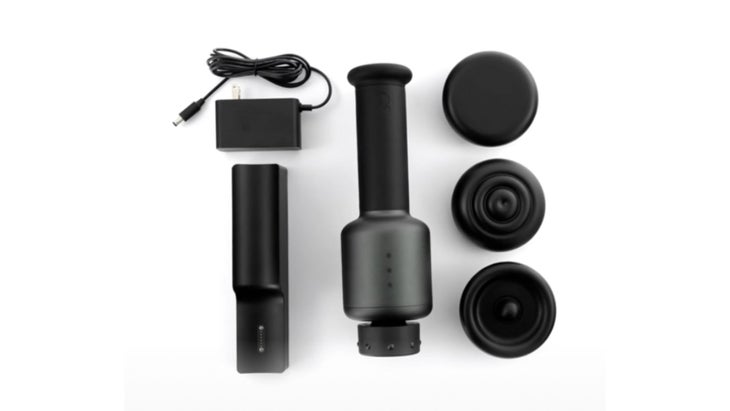
Rally Massage Gun
$499 at Rally
Unlike percussive massage guns, which drill into the muscle, Rally uses orbital technology. The massage head stimulates the skin and muscles by moving in small circles. So, instead of digging into a tight spot, you can glide over it (for $500).
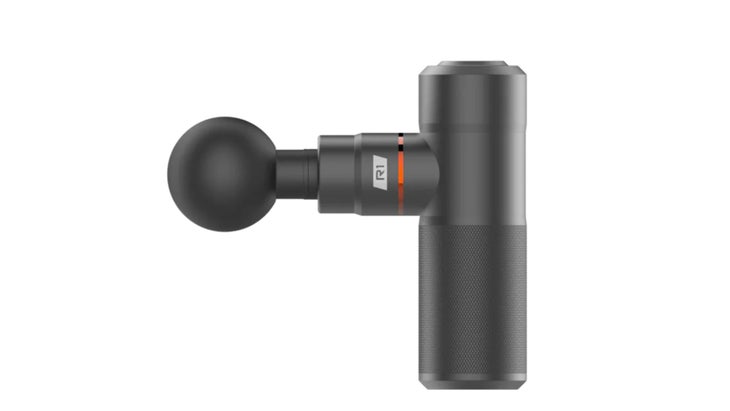
Roll Recovery – R1 Percussion
$129 at Roll Recovery
This super-compact tool has four speeds and four interchangeable heads so that you can customize your experience according to your preferences. For a gentle massage, keep the motor on the lowest setting and slip on the plushy foam head or the flat head.
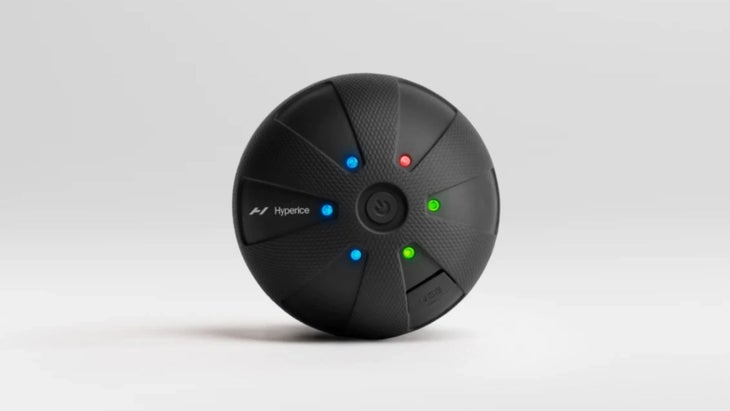
Hyperice Hypersphere Go
$109 at Hyperice
If you like the hands-free element of a lacrosse ball but want to bring a little extra juice to your rolling sessions, the Hypersphere Go from Hyperice is worth checking out. The rubber-coated massage ball contains a smaller, less powerful motor than most massage guns and vibrates at three different speeds. With a diameter of 3 inches (slightly bigger than a tennis ball), it’s small enough to keep on your desk.
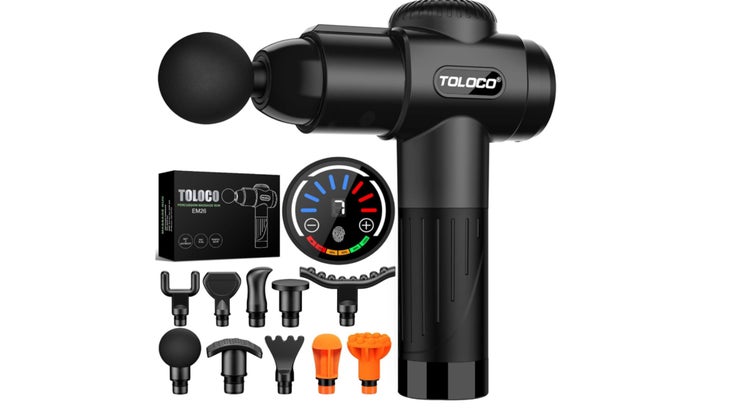
Toloco Massage Gun
$50 at Amazon
This tool goes for a fraction of the price of the more well-known brands, but it’s one of the most highly-rated massage guns on Amazon. For under $50, you get 10 interchangeable heads, and the gun itself operates on seven different settings. One through four are intended for “muscle wake up” and “fascial relaxation,” so keep the dial low and use the rounded or flat head.
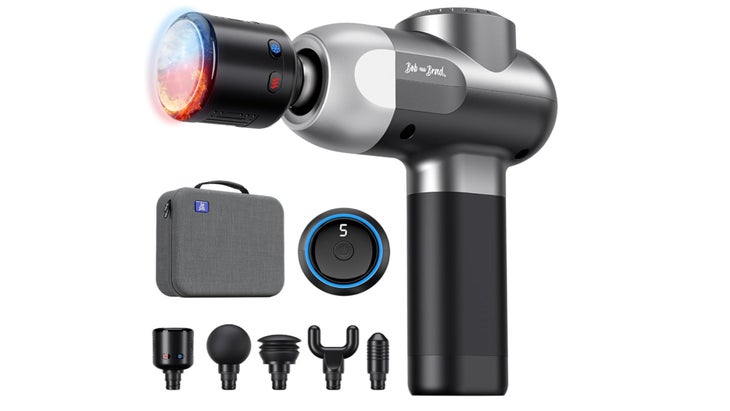
Bob and Brad Q2 Pro Mini Massage Gun with Heat and Cold Head
$90 at Amazon
If you find heat or cold therapy soothing, the Q2 Pro Mini from Bob and Brad is a solid (and relatively affordable) option. The primary attachment can offer either a cooling or warming sensation, or you can alternate between the two. The tool operates on five different speeds, so you can keep it on the first setting if you prefer a lighter touch.














